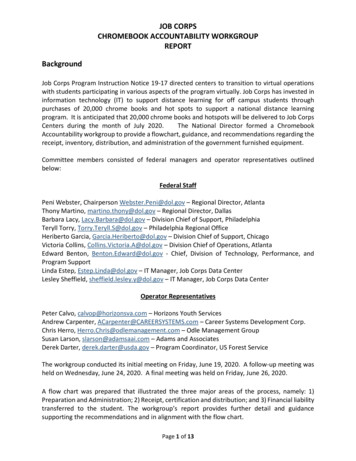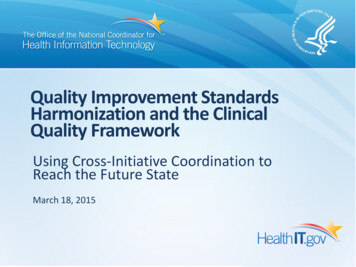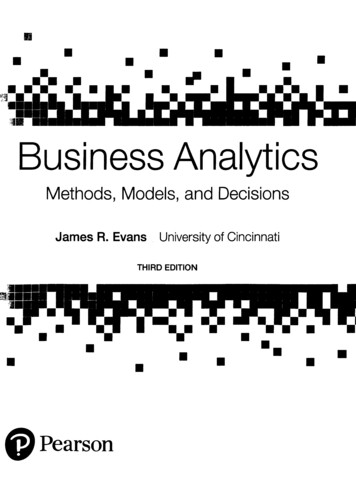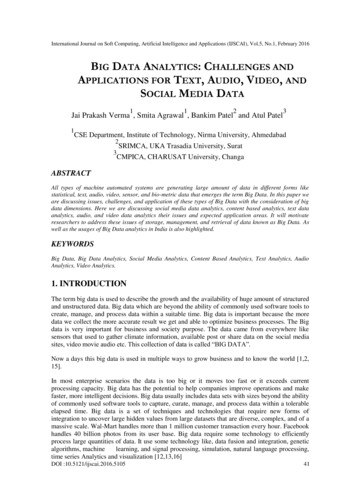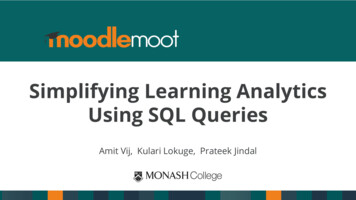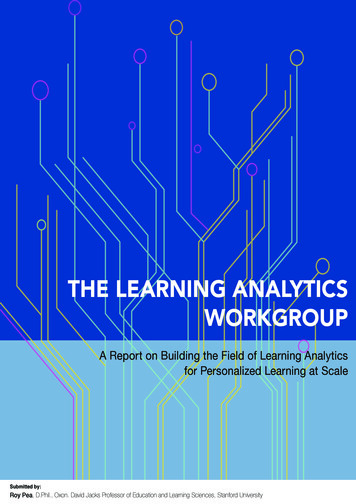
Transcription
THE LEARNING ANALYTICSWORKGROUPA Report on Building the Field of Learning Analyticsfor Personalized Learning at ScaleSubmitted by:Roy Pea, D.Phil., Oxon. David Jacks Professor of Education and Learning Sciences, Stanford University
Copyright 2014 Stanford UniversityAuthor Contact Information:Roy Pea, D.Phil., Oxon.David Jacks Professor of Education and Learning SciencesProfessor, Computer Science (Courtesy)Stanford University, Graduate School of Education, andDirector: H-STAR Institute (Human Sciences and Technologies Advanced Research)Wallenberg Hall450 Serra Mall, Building 160Stanford CA 94305-2055roypea@stanford.edu650.724.3720 OfficeThis report was made possible through a grant from the Bill & Melinda GatesFoundation and the MacArthur Foundation to the Board of Trustees of the LelandStanford Junior University. Special thanks to LAW team member Associate ProfessorTaylor Martin, Dr. Sarah Brasiel, and the Active Learning Lab of Utah State University,for their exceptional support in the final period of report preparation.The Learning Analytics Workgroup: A Report on Building the Field of LearningAnalytics for Personalized Learning at Scale by Roy Pea, D.Phil., Oxon, David JacksProfessor of Education and Learning Sciences, Stanford University is licensed undera Creative Commons Attribution-NonCommercial-NoDerivatives 4.0 InternationalLicense.
Table of ContentsLAW Project: Background and Purpose.1Section 1: A Conceptual Framework for Building theField of Learning Analytics .10Section 2: Critical Questions for Understanding Howto Build the Field of Learning Analtytics.23Section 3: Articulating and Prioritizing New Tools,Approaches, Policies, Markets, and ProgramsWithin the Field of Learning Analytics.42Section 4: Determining Resources Needed toAddress Priorities.47Section 5: Road Map for How to Implement the FieldBuilding Strategy and How to Evaluate Progress.61References.80
LAW Project: Background and PurposeLAW PROJECT:BACKGROUND AND PURPOSEThis brief section of the report sketches themotivating conditions for the creation of theproposed LAW Project and its current andplanned activities.1Building the Field of Learning Analyticsfor Personalized Learning at Scale
LAW Project: Background and PurposeThe Call for Change–The Birth of the LAW ProjectOn August 3, 2011, the Bill andMelinda Gates Foundation conveneda multisector group at the Universityof Chicago’s Computation Institute.The goal of the meeting, hosted by University ofChicago’s professor Ian Foster, was to considerhow to best build capacity in the field for creatingan innovative and sustainable ecosystemdedicated to advancing the state of learning dataand learning analytics on behalf of all children’sSeptember 2011, following thismeeting, LAW Principal InvestigatorRoy Pea drafted and shared a whitepaper for the Gates Foundation ona strategy for building the field oflearning analytics to address thesechallenges and opportunities.In a related development, the National Academyof Education convened a summit on December1-2, 2011 on adaptive educational technologiesin Washington, DC to consider how to best moveforward the research community’s understandingof available data from these technologies andto understand their possible applications inresearch and for educational improvement.2Building the Field of Learning Analyticsfor Personalized Learning at Scalecollege and career readiness. An emergentfocus during the meeting was on the impendingopportunities and challenges associated withunderstanding the orders of magnitude of datagenerated as millions of K-12 students andtheir teachers transition into digitally enabledteaching and learning compared to what ismanaged by today’s school data systems inutilizing those data to improve education.The message was that the growth of data ineducation surpasses the capacity to make senseof it and to employ insights derivable from thedata to guide practices.Broader discussions of the learning analyticsand personalized learning challenges andopportunities with Gates Foundation andother researchers and policy makers at theNational Academy of Education summit madeclear the importance of concerted actionto develop a multi-sector plan for buildingthe field of learning analytics in support ofimproving education. Accordingly, duringthe winter of 2011–2012, the proposal wasdeveloped at Stanford and in collaborationwith the funders for what would becomethe LAW Project, with funding committed inJuly 2012 and the first workshop planned forSeptember 21–22, 2012, at Stanford University.The LAW Project next would convene expertsin the field through workshops and conferencepanels to understand the needs and currentdevelopments to inform the building of the field.
LAW Project: Background and PurposeLAW PROJECT ACTIVITIES: SUMMARYFrom September 2012 through July 2014, the LAW Project planned and conducted four differentworkshops, planned and presented three conference panels, led a crowd-sourcing campaign forsoliciting learning analytics resources for the field, launched the first Learning Analytics SummerInstitute (LASI-13), commissioned 11 white papers on a variety of vital issues for building the field oflearning analytics, and completed this final report as a culmination of this work. This report would nothave been possible without the 37 contributors or advisors to the LAW Project, who represent multipleinterested sectors: 13 from the academy, 9 from for-profit companies, 7 from nonprofit organizations, 4from government, and 4 from philanthropic foundations. We provide an overview of each of these keyactivities as an important context for this report.WorkshopsFour workshops were held between September 2012 and March 2013. The dates, locations, and briefinformation about each workshop are provided in Table 1. The attendees for each workshop and theiraffiliations are provided in Table 2.Table 1. Four Workshops for the LAW ProjectWORKSHOPNUMBERLOCATIONAREA OF FOCUSWorkshop 1StanfordUniversitySeptember 21-22,2012Defining key clusters of issues for subgroupsto develop as task forcesWorkshop 2StanfordUniversityOctober 17-18,2012Continued work in task force groups to defineissuesWorkshop 3Washington,D.C.Seattle, WAWorkshop 43DATEGatesFoundationBuilding the Field of Learning Analyticsfor Personalized Learning at ScaleNovember 3, 2012March 14-15,2013Planned to overlap with the NationalAcademy of Education’s annual meeting toenlist a broader group of participants tocontribute to the research work and fieldbuilding activitiesDiscussions of the LAW project findings andopen issues with Gates Foundation ProgramOfficers
LAW Project: Background and PurposeTable 2. Workshop Attendees and Affliations4NAMEAFFILIATIONWORKSHOP #1234Ryan BakerTeachers College, Columbia UniversityXJohn BehrensPearson NSCMarie BienkowskiSRI InternationalPaulo BliksteinStanford UniversitySimon Buckingham ShumKnowledge Media Institute(KMI), Open UniversityXJohn Henry ClippingerMIT Media Lab &Institute for Institutional Innovation & DataDriven Design (ID3)XStephen CollerBill & Melinda Gates FoundationXEd DieterleBill & Melinda Gates FoundationXXJohn EastonUS Department of Education, Institute of Education Sciences(IES)XXMichelle EliaCPSIXIan FosterUniversity of ChicagoXPaul FranzStanford UniversityBernd GirodStanford UniversityXWayne GrantIntel CorporationXMyron GutmannNational Science Foundation (NSF), Directorate for Social,Behavioral, and Economic Sciences (SBE)Patricia HammarP.K. Hammar Legal and PKH EnterprisesRobert M. HauserNational Research CouncilTom KalilWhite House OSTP (Office of Science and Technology Policy)Kenneth R. KoedingerCarnegie Mellon University (CMU)Jace KohlmeierKhan AcademyDaphne KollerCoursera and Stanford UniversityL. Arthi KrishnaswamiRyeCatcher(Past: The College Board)Taylor MartinUtah State UniversityRobert J. MislevyETSJoan Ferrini-Mundyational Science Foundation (NSF), Directorate for Education andHuman Resources (EHR)Ari Bader-NatalMinervaDavid NiemiKaplanXZachary A. PardosWorkshop on Personalizing Learning (WPL) and UC BerkeleyXRoy PeaStanford UniversityXBuilding the Field of Learning Analyticsfor Personalized Learning at XXX
LAW Project: Background and PurposeTable 2. Workshop Attendees and Affliations (continued)NAMEAFFILIATIONWORKSHOP #1234Philip J. PietyJohns Hopkins UniversityXXPrasad RamGooruXXLauren ResnickUniversity of PittsburghXXPaul ResnickUniversity of Michigan School of InformationMartina A. RothIntel CorporationSteve SchoettlerJunyoXXHarry ShahGooruXJohn StamperHuman-Computer Interaction Institute, Carnegie MellonUniversity (CMU)XXXEmily SchneiderStanford UniversityXXXMarcelo WorsleyStanford UniversityXXMolly BullockStanford UniversityXXDarrell M. WestBrookings InstituteBob WiseAlliance for Excellent EducationXXXXXXXXXXThe participants at each workshop met in five task force groups todevelop knowledge and recommendations in one of five areas. Whatfollows is a summary of the work in each task force.Task Force 1Advancing Education DataThis task force focused on advancing education data. This task force discussed questions aboutthe value proposition for stakeholders, required competencies for education data scientists,and the resources for different stakeholders. They made recommendations for the options andpathways to train and foster education data scientists. They also provided recommendations foran online community for learning analytics resources and peer learning opportunities.Task Force 2Adapting Learning Technologies to EducationThis task force focused on questions about how to make learning technologies adapt to education.The goal is to evolve the infrastructure for learning analytics for K-12 digital curricula andassessments, e-texts and associated opportunities for big data education science. They focused onthe content and method of assessment and data collection. They also considered how to improvethe infrastructure according to target users and learning environments.5Building the Field of Learning Analyticsfor Personalized Learning at Scale
LAW Project: Background and PurposeTask Force 3Learning Science to Provide Personalized, Pervasive Learning at ScaleThis task force focused on learning science related to providing personalized, pervasive learningat scale across contexts. The three primary aspects discussed were connected learning models,multiplicity of learning resources, and recommended engines for learning resources andexperience. Some detailed topics about analysis of personalized learning were carefully discussedfrom different aspects like modes, outcome analysis, learning priorities, research methodologyand scope, learner models, transparency, and feedback research.Task Force 4Creating Multimodal Learning AnalyticsThis task force focused on how to create multimodal learning analytics to ensure that theeducation data include contextual features of learning environments. Two main questions werediscussed: What are the priority issues in providing the better theories, methods, and tools formultiple data streams? How can we achieve data privacy and anonymity when creating multimodallearning analytics?Task Force 5Data Privacy, Research IRB, and Ethical and Internet Protocol (IP) ConsiderationsThis task force focused on how to manage data privacy, research IRB, and ethical and IPconsiderations for learning in a networked world. In order to research this topic, the participantsanalyzed this question from the perspectives of different stakeholders, and they tried to lookfor policy and practice, protection options for different learning contexts or demographics, andmethods of data storage and sharing.6Building the Field of Learning Analyticsfor Personalized Learning at Scale
LAW Project: Background and PurposeConference Panels to ShareKnowledge and Rally ParticipationNext, three conference panels were developed for two purposes: knowledge sharing and rallying toattract talented data scientists, analysts, and developers to the cause. The sessions were planned forvenues where learning scientists and educational researchers rarely go—the data science orientedtrade conferences hosted by O’Reilly. This effort also included one keynote presentation (see Table 3).Table 3. Conferences Related to the LAW ProjectConferenceStrataStrataSXSW-EduLocationNew York,NYSantaClara, CAAustin, TXDateOctober 24, 2012February 27, 2013March 6, 2013KeynoteKeynote SpeakerPanel TitlePanelists“Data Exponential: K-12Learning Analytics forPersonalized Learning atScale—Opportunities &Challenges”Roy Pea, KennethKoedinger, TaylorMartin, Stephen CollerMorning Keynote: “UsingData to Honor the HumanRight to Education”Keynote: Prasad RamPanel: “Learning’s ClarionCall: Teaming to ImproveU.S. Education With BigData Science”“Building the Field ofLearning Analytics”Panelists: MarieBienkowski, JaceKohlmeier, Zachary A.Pardos, Sharren BatesRoy Pea (Chair),Stephen Coller, KenKoedinger, TaylorMartinThe First Learning Analytics SummerInstitute (LASI 2013)This project was co-funded by the Bill and Melinda Gates Foundation. The event was co-organized by RoyPea, Taylor Martin, Dragon Gasevic, and John Behrens. This was a strategic 5-day event, July 1–5, 2013,attended by people from all over the world in person or virtually. The objective was for participants to beequipped to actively engage in advancing the learning analytics field through their teaching and researchactivities.7Building the Field of Learning Analyticsfor Personalized Learning at Scale
LAW Project: Background and PurposeCrowd-sourcing Campaign for SolicitingLearning Analytics ResourcesThe 11 categories for which we sought contributionswere as follows (in alphabetical order):SS Companies and NonProfitsSS Conferences and SocietiesSS Courses and SyllabiSS Data Science-OtherSS Degree/CertificateProgramsSS Grant OpportunitiesSS News/Blogs/ReportsSS Research LabsSS Research PublicationsSS Success CasesSS Tools and AlgorithmsAnother activity to build networksand elicit learning analytics fieldbuilding resources involved using theIdeaScale crowd-sourcing platform.Both the LAW membership andthe LASI 2013 program applicantswere invited to contribute resourcesof various kinds to the platformfor our uses in developing theLAW final report (see ).Over 300 resources were contributedby over 100 individuals.History of the Development of the Field of Learning Analytics»» 1990’s Research in Intelligent Tutoring Systems»» 2008 International Educational Data Mining Society first conference is held»» 2009 First publication of the Journal on Education Data Mining»» 2011 First International Conference on Learning Analytics and Knowledge»» 2011 Founding of the Society for Learning Analytics Research»» 2013 Journal of Learning Analytics is established—For more information, see Martin and Sherin’s (2013) introduction in the special issue ofThe Journal of the Learning Sciences, “Learning Analytics and Computational Techniques forDetecting and Evaluating Patterns in Learning.”8Building the Field of Learning Analyticsfor Personalized Learning at Scale
LAW Project: Background and PurposeWhite PapersFinally, over the initial period of the LAW Project, as we conducted the workshops and surveyed theavailable literature in the field, priorities were developed for a set of 11 white papers that we felt wereneeded to build out specific issues for which a concerted and focused research and synthesis effort waswarranted. The titles and authors of the 11 white papers developed are provided in Table 4.Table 4. White Paper Titles and AuthorsAUTHOR(S)WHITE PAPER TITLERyan Baker, Kenneth KoedingerTowards Demonstrating the Value of Learning Analytics for K-12 EducationJohn Behrens, Bob Mislevy, PhilPiety, Kristen diCerboInferential Foundations for Learning Analytics in the Digital OceanMarie BienkowskiPutting the Learner at the Center: Exposing Analytics to Learning ParticipantsPaulo BliksteinMultimodal Learning Analytics and Assessment of Open-Ended ArtifactsJohn ClippingerInBloom: Building Trust for The Protected Sharing and Analysis of StudentData for Personalized LearningTrish HammarLearning Analytics Ecosystem Could be Fostered by Institutional Review Board(IRB) ReformL. Arthi KrishnaswamiUser Experience Techniques for Advancing and Communicating LearningAnalyticsTaylor MartinConnected Learning, Education Data Science, and Big(gish) DataDavid Niemi, Richard ClarkUsing Learning Analytics to Improve Academic PersistenceLauren Resnick, Carolyn Rose,Sherice ClarkeConversation AnalyticsMary Ann Wolf, Bob WisePolicy and Capacity Enablers and Barriers for Learning AnalyticsThe result of these efforts of the LAW Project is the culmination of a final report, which includes thesections that follow:A ConceptualFrameworkfor Buildingthe Fieldof LearningAnalyticsCriticalQuestions forUnderstandingHow to Buildthe Fieldof LearningAnalyticsArticulatingand PrioritizingNew Tools,Approaches,Policies, Markets,and Programs ofStudy Within theField of LearningAnalyticsDeterminingResourcesNeeded toAddressPrioritiesRoad Mapfor How toImplement theField BuildingStrategyand Howto EvaluateProgressThe purposes of the LAW Project have been advancing each of these objectives, which we hope to makeclear in the remainder of this report.9Building the Field of Learning Analyticsfor Personalized Learning at Scale
Section 1SECTION 1A Conceptual Framework for Buildingthe Field of Learning Analytics10Building the Field of Learning Analyticsfor Personalized Learning at Scale
Section 1College and Career SuccessMany students come to college unprepared, as evidenced by as many as 40% of 1st-year collegestudents being placed in developmental courses, with fewer than 60% of students completing collegewithin 6 years. With technological advances, there are new ways to provide support to students toimprove college and career readiness. In order for students to develop adaptive expertise to succeedin their college and careers, they need to have opportunities to develop and implement scientificprocesses, inquiry, critical thinking, and creativity, to name a few such skills.Teachers, school administrators, parents, and students need to track learning activity and progressto accomplish the goal of college and career success for all students. As teachers and administratorsare responsible for tracking the progress of many students, there is a need to be able to visualizelearning at different levels of aggregation and use that information to guide their decision making.Such visualizations of learning progress can guide further instructional interventions and provisionof progressive learning resources and experiences. Unfortunately, we fall behind when it comes toproviding teachers, administrators, and families with the tools that they need to track progress and toensure all students achieve college and career success.Where We Fall BehindIt is noteworthy that there are ingrained historical reasons underlying the nonpersonalized learningthat is commonplace practice today in the United States. Education historian Patricia Graham (2005) hashighlighted how, early in the 20th century, a period of massive assimilation due to America’s growingimmigrant population and the transition from farming to an industrialized society based in cities led tovast expansions in the quantity and size of schools and a rigid common curriculum, organized by grades.The industrial factory model was broadly adopted for education and developed mass production anddistribution of curriculum materials and teaching techniques. This industrial era of instructional designtended to provide all students with uniform learning experiences, requiring them to adapt to how, when,and where instruction was provided. This instructional philosophy and practice, still prevalent today,conflicts with contemporary research into how people learn (Bransford, Brown, & Cocking, 2000), whichreveals that, with enough access to “learning opportunities” (Moss, Pullin, Gee, Haertel, & Young, 2008),time, guidance, appropriate “mindset” about intelligence (Dweck, 2007) and persistence (Duckworth &Seligman, 2005), almost everyone can learn just about anything to a great extent, and yet almost noone learns exactly the same way, through the same pathways. This understanding and desire to makeand change educational experiences so that they are appropriate for every learner defines the need forpersonalized learning.11Building the Field of Learning Analyticsfor Personalized Learning at Scale
Section 1Graham (2005) also observed how schools inthe United States following WW I began to seekto customize education by accommodatingto the needs of children of distinct abilitiesand interests. For example, John Dewey’spedagogical innovation in “learning by doing”was an inspiration for later cognitive and sociallearning theories. In addition, the Brown v.Board of Education Supreme Court decision of1954 sought to increase access to education fordiverse populations, including minority and lowincome students and children with disabilities,which was followed by the Elementary andSecondary Education Act of 1965 to expandeducation opportunities.Where modern instructional theories advocatefor equalization of learning opportunities andpersonalized learning, an inability to leveragesimultaneously (a) an economy of scale and (b)learning analytics and education data miningby data scientists at scale has limited andrestricted the scope and freedom to implementpersonalized learning widely. Another limitationhas been the splintered learning standardsacross the states. But now most states areemploying the Common Core State Standards inMathematics and English Language Arts, and over40 states are in early implementation planningfor the newly released Next Generation ScienceStandards. The LAW Project has been focused onmaking progress towards personalizing learningat scale by building the field of learning analyticsto support and advance initiatives and multi-stateor national technology infrastructure to supportnew ecosystems of personalized learning andteaching. Next, we discuss the importance ofpersonalized learning and what learning analyticscan contribute.“Failure to support this effort ordelaying its initiation will hamperour country’s ability to providepersonalized learning at scale toall students, with correspondinglosses to the intellectual diversityand value of our graduates to theworkforce and society at large.”What is PersonalizedLearning?The National Academy of Engineering (2008) identified 14 grand challenges humans must solve tosustain and improve the human condition for current and future generations. The proposed efforttargets the challenge that they identified of advancing personalized learning at scale for all learnerswith varying needs, skill levels, interests, dispositions, and abilities, arguing that continuously capturing,deriving meaning from, and acting on the production of vast volumes of data produced by learnersengaged with digital tools are activities fundamental to personalized learning. A similarly framed grandchallenge on personalized learning was proposed in the 2010 National Education Technology Plan (U.S.Department of Education, 2010). To effectively address this challenge head on will require a deliberate,consorted, and sustained effort by the academy and nonprofits, industry, government, privatefoundations, and practitioners to build the field of learning analytics and the associated human capital,12Building the Field of Learning Analyticsfor Personalized Learning at Scale
Section 1tools, and scientific knowledge capable of processing for strategic application the data of digital learning,data that are now growing exponentially. Failure to support this effort or delaying its initiation willhamper our country’s ability to provide personalized learning at scale to all students, with correspondinglosses to the intellectual diversity and value of our graduates to the workforce and society at large.The authors of the 2010 National Education Technology Plan sought to provide clarity to the concept ofpersonalized learning vis-à-vis related concepts: individualization, differentiation, and personalization.These terms have become buzzwords in education, but little agreement exists on what exactly theymean, beyond the broad concept that each is an alternative to the one-size-fits-all model of teachingand learning. For example, some education professionals use personalization to mean that students aregiven the choice of what and how they learn according to their interests, and others use it to suggestthat instruction is paced differently for different students. Throughout this plan, we use the followingdefinitions for these key terms.PERSONALIZED LEARNING CONCEPTSIndividualizationInstruction that is paced to the learning needs of different learners. Learning goals are thesame for all students, but students can progress through the material at different speedsaccording to their learning needs. For example, students might take longer to progressthrough a given topic, skip topics that cover information they already know, or repeattopics on which they need more help.DifferentiationInstruction that is tailored to the learning preferences of different learners. Learning goalsare the same for all students, but the method or approach of instruction varies accordingto the preferences of each student or what research has found works best for students likethem.PersonalizationInstruction that is paced to learning needs, tailored to learning preferences, and tailored tothe specific interests of different learners.In an environment that is fully personalized, the learning objectives and content as well as the methodand pace may all vary (so personalization encompasses differentiation and individualization).13Building the Field of Learning Analyticsfor Personalized Learning at Scale
Section 1Why does PersonalizedLearning Matter?There are many important arguments for the importance of personalizedlearning for education. The ones we review here include:»» Supporting learning for all students»» Improving educational performance»» Facilitating cost efficiencies through educationalproductivity and organizational optimization»» Accelerating educational innovationSUPPORTING LEARNING FOR ALL STUDENTSThe 2010 National Education Technology Plan (U.S. Department of Education, 2010) called out theimportance of making progress on personalized learning so as to support learning for the full spectrumof U.S. students:"The always-on nature of the Internet and mobile access devicesprovides our education system with the opportunity to createlearning experiences that are available anytime and anywhere.When combined with design principles for personalized learningand UDL [Universal Design for Learning], these experiences alsocan be accessed by learners who have been marginalized in manyeducational settings: students from low-income communities andminorities, English language learners, students with disabilities,students who are gifted and talented, students from diverse culturesand linguistic backgrounds, and students in rural areas. (p. 23) "14Building the Field of Learning Analyticsfor Personalized Learning at Scale
Section 1In the following box we provide an overview of universal design, UDL, and three important coreprinciples to make learning accessible to all students.UNIVERSAL DESIGN“Making learning experiences accessible to all learners requires universal design, a concept wellestablished in the field of architecture, where all modern public buildings, including schools,are designed to be accessible by everyone. Principles and guidelines have been established foruniversal design in education based on decades of research and are known as Universal Designfor Learning (UDL)” (U.S. Department of Education, 2010, p. 19). The 2010 National EducationTechnology Plan (U.S. Department of Education, 2010) lists three core principles for UDL, asfollows:»» Provide multiple and flexible methods of presentation of informationand knowledge. Examples include digital books, specialized softwareand websites, text-to-speech applications, and screen readers.»» Provide multiple and flexible means of expression with alternatives forstudents to demonstrate what they have learned. Examples includeonline concept mapping and speech-to-text programs.»» Provide multiple and flexible means of engagement to tap into diverselearners’ interests, challenge them appropriately, and motivate them tolearn. Examples include choices among different scenarios or contentfor learning the same competency and opportunities for increasedcollaboration or scaffolding.IMPROVED EDUCATIONAL PERFORMANCETwo factors work together to facilitate improved performance.We can anticipate improved outcomes on traditional measures of learning,since we are teaching what we have always taught but more effectively byvirtue of the value added by learning analytics. One prominent example isimplementing mastery learning in American classrooms at scale with theCognitive Tutor learning software and associated curriculum (e.g., Pane,McCaffrey, Slaughter, Steele, & Ikemoto, 2010; Ritter, Anderson, Koedinger, & Corbett, 2007; Ritter,Kulikowich, Lei, McGuire, & Morgan, 2007). Cognitive Tutor software was developed around an artificialintelligence model, where a student’s weaknesses in terms of concept mastery are identified and then aset of problems are customized for the student along with customized prompts to focus on areas whereFIRST15Building the Field of Learning Analyticsfor Personalized Learning at Scale
Section 1the stude
New York, NY October 24, 2012 "Data Exponential: K-12 Learning Analytics for Personalized Learning at Scale—Opportunities & Challenges" Roy Pea, Kenneth Koedinger, Taylor Martin, Stephen Coller Strata Santa Clara, CA February 27, 2013 Morning Keynote: "Using "Building the Field of Learning Analytics"


